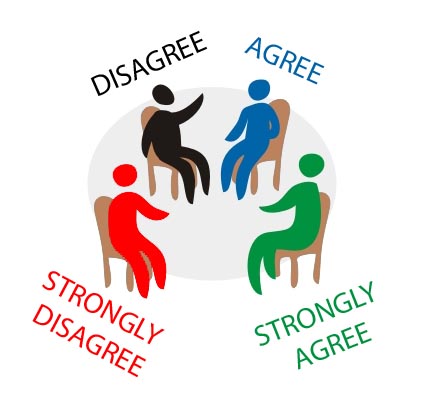Why does Oral Communication Scare Students?
When students hear oral communication, they immediately think of public speaking; the scary moment of delivering a speech in front of their entire class. Talking in front of the entire class is nerve-racking and anxiety-calling for some. It is important that as teachers, we give students numerous, and different, opportunities to listen and talk about topics and to develop and apply a variety of speaking skills.
Strategies for Teaching Oral Communication Skills
1. Make it fun
How? Through careful consideration, teachers can gamify certain aspects of oral communication for students. There is an app called Goose Chase in which teachers can create scavenger hunts for students, sending them on missions where they have to communicate with different audiences. At the same time, they get to compete with their classmates for points, get to move around the school and can have a good laugh completing certain missions.
Does this meet the curriculum expectations? One of the overall expectations in the Ontario Curriculum for the oral communication strand states, "students will use speaking skills and strategies appropriately to communicate with different audiences for a variety of purposes" (p. 9).
What does this look like in use? I've been lucky enough to practice my oral communication skills using this app with my EDBE 8P24 class. In groups, we were tasked to complete a variety of missions that required us to talk to strangers, recreate movie scenes, shout random phrases, and many more. My team decided to devise a game plan before we started: we would complete as many tasks in one area as we could before moving to the next area so that we could move quickly. To come up with this plan, we verbally brainstormed based on the tasks we had in front of us.
One of our missions was called "Reading Time!". In this task, we had to read a storybook aloud to a stranger. Oral communication skills are being practiced through the read-aloud of the book by adjusting your voice to fit the story, and by approaching the stranger to ask if you can read the book to them by using the necessary speaking skills to ask them the question.
One more of our missions was called "Tableau". In this task, we had to create a tableau that represented one of the overall expectations for oral communication. We chose to demonstrate "students will listen in order to understand and respond appropriately in a variety of situations for a variety of purposes" (p. 9). Listening skills are often forgotten about in oral communication so it is important that we also teach students how to be active listeners.

2. Promote opportunities for classroom talk
How? There are numerous different ways that teachers can promote Classroom Talk for students, giving them different opportunities to practice their oral communication skills. Teachers should provide students with explicit instruction to build their strengths, and a safe and encouraging environment to practice their skills.
Does this meet the curriculum expectations? One of the overall expectations in the Ontario Curriculum for the oral communication strand states, "students will reflect on and identify their strengths as listeners and speakers, areas for improvement, and strategies they found most helpful in oral communication situations." (p. 10).
What does this look like in use? Some strategies that teachers can choose from to promote opportunities for classroom talk are pair work, small group discussions, whole-class discussions, and presentations.
Think-Pair-Share is a great strategy to ensure that all students are talking. In this strategy, students first reflect on a topic, deepen their understanding by chatting with a partner, then sharing in a whole-group discussion in which they would also be practicing their listening skills.

Four Corners is a great strategy to have students talk in small groups about an issue they all agree on. In this strategy, students physically respond to a statement by moving to a corner in the room labeled "strongly agree", "agree", "disagree", or "strongly disagree", in which they then discuss why they chose that response amongst the others who also did.
Jigsaw is a great strategy to have students communicate their "expertise". In this strategy, students are numbered 1-5 in their home groups and then move to an expert group to discuss a certain aspect of the topic. They then return to their home group and share the knowledge they discussed with their expert group. This allows students to be both speakers and listeners in small-groups.

Keep Encouraging Speaking and Listening!
If there could be one takeaway from teaching oral communication skills, it is that conversations should always be encouraged in the classroom. Class conversations promote both speaking and listening and provide students with many different strategies to enhance those skills.
References
Four Corners Strategy (Online Image). Retrieved from
Goose
Chase App (Online Image). Retrieved from https://teacherstechtoolbox.com/?p=749.
Jigsaw Strategy (Online Image). Retrieved from
Ontario Ministry of Education (2006). Language. The Ontario Curriculum, Grades 1-8. Ministry of Education. Retrieved from http://www.edu.gov.on.ca/eng/curriculum/elementary/language18currb.pdf.
Ontario Ministry of Education (n. d.). Think Literacy. Cross-Curricular Approaches, Grades 7-12. Ministry of Education. Retrieved from http://www.edu.gov.on.ca/eng/studentsuccess/thinkliteracy/files/Oral.pdf.
Think, Pair, Share Strategy (Online Image). Retrieved from https://www.semanticscholar.org/paper/Using-The-Think-Pair-Share-(TPS)-Strategy-to-of-The-Apriani/706c60467a87baa9179072083ce6226d1e7bfb90/figure/0.





